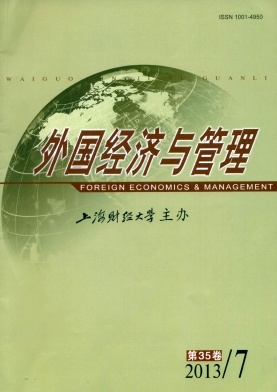基于战略视角的企业边界研究前沿探析
外国经济与管理 2013 年 第 35 卷第 07 期, 页码:2 - 11
摘要
参考文献
摘要
现有的企业边界研究主要基于效率和战略两个不同的视角,前者以经济学研究居多,而后者则以管理学研究为主。本文先从企业边界的表现形式、决定和演化机制、影响因素三个方面,对进入21世纪以来国外管理学者基于战略视角的企业边界研究进行了总结性回顾,然后分析了现有相关研究仍存在的不足,并阐述了未来相关研究应该关注的问题。
[1]Afuah A.Dynamic boundaries of the firm:Are firms better off being vertically integrated in the face of a technological change?[J].Academy of Management Journal,2001,44(6):1211-1228.
[2]Afuah A.Redefining firm boundaries in the face of the Internet:Are firms really shrinking?[J].Academy of Management Review,2003,28(1):34-53.
[3]Araujo L,et al.The multiple boundaries of the firm[J].Journal of Management Studies,2003,40(5):1255-1277.
[4]Argyres N S and Zenger T R.Capabilities,transaction costs,and firm boundaries[J].Organization Science,2012,23(6):1643-1657.
[5]Barney J B.How a firm’s capabilities affect boundary decisions[J].Sloan Management Review,1999,40(3):137-146.
[6]Brusoni S,et al.Knowledge specialization,organizational cou-pling,and the boundaries of the firm:Why do firms know more than they make?[J].Administrative Science Quarterly,2001,46(4):597-621.
[7]Collis D J and Noda T.The evolution of intra-industry firm heterogeneity:Insights from a process study[J].Academy of Management Journal,2001,44(4):897-925.
[8]Dewett T T and Jones T R.The role of information technology in the organization:A review,model and assessment[J].Jour-nal of Management,2001,27(3):313-346.
[9]Diez-Vial I.Explaining vertical integration strategies:Market power,transactional attributes and capabilities[J].Journal of Management Studies,2007,44(6):1017-1040.
[10]Hitt L M.Information technology and firm boundaries:Evi-dence from panel data[J].Information Systems Research,1999,10(2):134-149.
[11]Hoetker G.How much you know versus how well I know you:Selecting a supplier for a technically innovative component[J].Strategic Management Journal,2005,26(1):75-96.
[12]Jacobides M G and Winter S G.The co-evolution of capabili-ties and transaction costs:Explaining the institutional struc-ture of production[J].Strategic Management Journal,2005,26(5):395-414.
[13]Jacobides M G and Hitt L M.Losing sight of the forest for the trees?Productive capabilities and gains from trade as drivers of vertical scope[J].Strategic Management Journal,2005,26(13):1209-1227.
[14]Jacobides M G and Billinger S.Designing the boundaries of the firm:From“make,buy,or ally”to the dynamic benefits of vertical architecture[J].Organization Science,2006,17(2):249-261.
[15]Langlois R N and Robertson P L.Firms,markets and eco-nomic change[M].Florence,KY,USA:Routledge,1995.
[16]Leiblein M J and Miller D J.An empirical examination of transaction-and firm-level influences on the vertical boundaries of the firm[J].Strategic Management Journal,2003,24(9):839-859.
[17]Macher J T.Technological development and the boundaries of the firm:A knowledge-based examination in semiconductor manufacturing[J].Management Science,2006,52(6):826-843.
[18]Macher J T and Boerner C.Technological development at the boundaries of the firm:A knowledge-based examination in drug development[J].Strategic Management Journal,2012,33(9):1016-1036.
[19]Madhok A.Reassessing the fundamentals and beyond:Ronald Coase,the transaction costs and resource-based theories of the firm and the institutional structure of production[J].Strategic Management Journal,2002,23(6):535-550.
[20]Mota J.and Castro L M.A capabilities perspective on the e-volution of firm boundaries:A comparative case example from the Portuguese moulds industry[J].Journal of Management Studies,2004,41(2):295-316.
[21]Nickerson J A and Zenger T R.A knowledge-based theory of governance choice—A problem-solving approach[J].Or-ganization Science,2004,15(6):617-632.
[22]Parmigiani A and Mitchell W.Complementarity,capabili-ties,and the boundaries of the firm:The impact of within-firm and interfirm expertise on concurrent sourcing of comple-mentary components[J].Strategic Management Journal,2009,30(10):1065-1091.
[23]Santos F M and Eisenhardt K M.Organizational boundaries and theories of organization[J].Organization Science,2005,16(5):491-508.
[24]Williamson O E.The economic institutions of capitalism[M].New York:Free Press,1985.
[25]Williamson O E.Strategy research:Governance and compe-tence perspectives[J].Strategic Management Journal,1999,20(12):1087-1108.
[26]Wolter C and Veloso F M.The effects of innovation on ver-tical structure:Perspectives on transaction costs and compe-tences[J].Academy of Management Review,2008,33(3):586-605.
[27]Yang H B,et al.A multilevel framework of firm bounda-ries:Firm characteristics,dyadic differences,and network at-tributes[J].Strategic Management Journal,2010,31(3):237-261.
[28]Zollo M and Winter S G.Deliberate learning and the evolu-tion of dynamic capabilities[J].Organization Science,2002,13(3):339-351.
[29]Ashkenas R等.无边界组织[M].(姜文波译).北京:机械工业出版社,2005.
[30]Paulsen N,Hernes T.组织边界管理:多元化观点[M].(佟博译).北京:经济管理出版社,2005.
[2]Afuah A.Redefining firm boundaries in the face of the Internet:Are firms really shrinking?[J].Academy of Management Review,2003,28(1):34-53.
[3]Araujo L,et al.The multiple boundaries of the firm[J].Journal of Management Studies,2003,40(5):1255-1277.
[4]Argyres N S and Zenger T R.Capabilities,transaction costs,and firm boundaries[J].Organization Science,2012,23(6):1643-1657.
[5]Barney J B.How a firm’s capabilities affect boundary decisions[J].Sloan Management Review,1999,40(3):137-146.
[6]Brusoni S,et al.Knowledge specialization,organizational cou-pling,and the boundaries of the firm:Why do firms know more than they make?[J].Administrative Science Quarterly,2001,46(4):597-621.
[7]Collis D J and Noda T.The evolution of intra-industry firm heterogeneity:Insights from a process study[J].Academy of Management Journal,2001,44(4):897-925.
[8]Dewett T T and Jones T R.The role of information technology in the organization:A review,model and assessment[J].Jour-nal of Management,2001,27(3):313-346.
[9]Diez-Vial I.Explaining vertical integration strategies:Market power,transactional attributes and capabilities[J].Journal of Management Studies,2007,44(6):1017-1040.
[10]Hitt L M.Information technology and firm boundaries:Evi-dence from panel data[J].Information Systems Research,1999,10(2):134-149.
[11]Hoetker G.How much you know versus how well I know you:Selecting a supplier for a technically innovative component[J].Strategic Management Journal,2005,26(1):75-96.
[12]Jacobides M G and Winter S G.The co-evolution of capabili-ties and transaction costs:Explaining the institutional struc-ture of production[J].Strategic Management Journal,2005,26(5):395-414.
[13]Jacobides M G and Hitt L M.Losing sight of the forest for the trees?Productive capabilities and gains from trade as drivers of vertical scope[J].Strategic Management Journal,2005,26(13):1209-1227.
[14]Jacobides M G and Billinger S.Designing the boundaries of the firm:From“make,buy,or ally”to the dynamic benefits of vertical architecture[J].Organization Science,2006,17(2):249-261.
[15]Langlois R N and Robertson P L.Firms,markets and eco-nomic change[M].Florence,KY,USA:Routledge,1995.
[16]Leiblein M J and Miller D J.An empirical examination of transaction-and firm-level influences on the vertical boundaries of the firm[J].Strategic Management Journal,2003,24(9):839-859.
[17]Macher J T.Technological development and the boundaries of the firm:A knowledge-based examination in semiconductor manufacturing[J].Management Science,2006,52(6):826-843.
[18]Macher J T and Boerner C.Technological development at the boundaries of the firm:A knowledge-based examination in drug development[J].Strategic Management Journal,2012,33(9):1016-1036.
[19]Madhok A.Reassessing the fundamentals and beyond:Ronald Coase,the transaction costs and resource-based theories of the firm and the institutional structure of production[J].Strategic Management Journal,2002,23(6):535-550.
[20]Mota J.and Castro L M.A capabilities perspective on the e-volution of firm boundaries:A comparative case example from the Portuguese moulds industry[J].Journal of Management Studies,2004,41(2):295-316.
[21]Nickerson J A and Zenger T R.A knowledge-based theory of governance choice—A problem-solving approach[J].Or-ganization Science,2004,15(6):617-632.
[22]Parmigiani A and Mitchell W.Complementarity,capabili-ties,and the boundaries of the firm:The impact of within-firm and interfirm expertise on concurrent sourcing of comple-mentary components[J].Strategic Management Journal,2009,30(10):1065-1091.
[23]Santos F M and Eisenhardt K M.Organizational boundaries and theories of organization[J].Organization Science,2005,16(5):491-508.
[24]Williamson O E.The economic institutions of capitalism[M].New York:Free Press,1985.
[25]Williamson O E.Strategy research:Governance and compe-tence perspectives[J].Strategic Management Journal,1999,20(12):1087-1108.
[26]Wolter C and Veloso F M.The effects of innovation on ver-tical structure:Perspectives on transaction costs and compe-tences[J].Academy of Management Review,2008,33(3):586-605.
[27]Yang H B,et al.A multilevel framework of firm bounda-ries:Firm characteristics,dyadic differences,and network at-tributes[J].Strategic Management Journal,2010,31(3):237-261.
[28]Zollo M and Winter S G.Deliberate learning and the evolu-tion of dynamic capabilities[J].Organization Science,2002,13(3):339-351.
[29]Ashkenas R等.无边界组织[M].(姜文波译).北京:机械工业出版社,2005.
[30]Paulsen N,Hernes T.组织边界管理:多元化观点[M].(佟博译).北京:经济管理出版社,2005.
引用本文
曾楚宏, 朱仁宏. 基于战略视角的企业边界研究前沿探析[J]. 外国经济与管理, 2013, 35(7): 2–11.
导出参考文献,格式为:





 6202
6202  723
723

